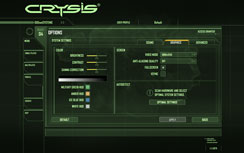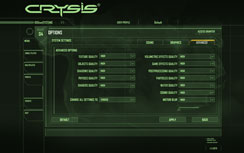MSI GTX 285 HydroGen OC Review
Written by Antony Leather
July 9, 2009 | 10:50
Tags: #benchmark #gtx-275 #gtx-285 #gtx-295 #h20 #hd4870x2 #hydrogen #inside #overclock #pictures #radiator #result #review #temperature #water #waterblock #watercooled #wc

Crysis
Publisher: Electronic ArtsCrysis is seen by many as the poster boy for DirectX 10 and it will make your system cry, quite literally – it’s a monster! It doesn’t come as much of a surprise then, that the graphics are something special – they’re above and beyond anything we’ve ever seen in a PC game.
We tested the game using the 64-bit executable under DirectX 10 mode with the 1.21 patch applied. We used a custom timedemo recorded from the Laws of Nature level which is more representative of gameplay than the built-in benchmark that renders things much faster than you're going to experience in game. We found that around 27-33 fps in our custom timedemo was sufficient enough to obtain a playable frame rate through the game. It's a little different to other games in that the low frame rates still appear to be quite smooth.
We set all of the in-game details to Very High and forced 8x anisotropic filtering in the driver menu as there is currently no support for it in game. We tested at 1,280 x 1,024, using 0x, 2x and 4x anti-aliasing, 1,680 x 1,050 using 0x and 4xAA, 1,920 x 1,200 using 0x and 2xAA and 2,560 x 1,600 with 0xAA and 2xAA. By extensively testing using anti-aliasing in very high resolutions in conjunction to Very High quality, we'll be pushing even the bleeding edge hardware on test to the limit.
Crysis
1,280 x 1,024 0xAA 16xAF, DirectX 10, Very High Quality
- ATI Radeon HD 4870 X2 2GB
- MSI GTX 285 HydroGen OC
- Nvidia GeForce GTX 285 1GB
- Nvidia GeForce GTX 275 896MB
- Sapphire Radeon HD 4890 1GB Atomic
- ATI Radeon HD 4890 1GB
-
-
48.3
-
28.0
-
-
-
44.2
-
24.0
-
-
-
42.2
-
24.0
-
-
-
38.9
-
23.0
-
-
-
38.7
-
22.0
-
-
-
33.8
-
18.0
-
0
10
20
30
40
50
Frames Per Second
-
Average
-
Minimum
Crysis
1,280 x 1,024 4xAA 16xAF, DirectX 10, Very High Quality
- ATI Radeon HD 4870 X2 2GB
- MSI GTX 285 HydroGen OC
- Nvidia GeForce GTX 285 1GB
- Nvidia GeForce GTX 275 896MB
- Sapphire Radeon HD 4890 1GB Atomic
- ATI Radeon HD 4890 1GB
-
-
42.0
-
22.0
-
-
-
38.2
-
22.0
-
-
-
36.4
-
21.0
-
-
-
33.3
-
20.0
-
-
-
32.0
-
15.0
-
-
-
28.7
-
14.0
-
0
10
20
30
40
Frames Per Second
-
Average
-
Minimum
Crysis
1,680 x 1,050 0xAA 16xAF, DirectX 10, Very High Quality
- ATI Radeon HD 4870 X2 2GB
- MSI GTX 285 HydroGen OC
- Nvidia GeForce GTX 285 1GB
- Nvidia GeForce GTX 275 896MB
- Sapphire Radeon HD 4890 1GB Atomic
- ATI Radeon HD 4890 1GB
-
-
39.8
-
23.0
-
-
-
35.4
-
20.0
-
-
-
34.0
-
20.0
-
-
-
31.4
-
19.0
-
-
-
30.6
-
17.0
-
-
-
26.9
-
15.0
-
0
10
20
30
40
Frames Per Second
-
Average
-
Minimum
Crysis
1,680 x 1,050 4xAA 16xAF, DirectX 10, Very High Quality
- ATI Radeon HD 4870 X2 2GB
- MSI GTX 285 HydroGen OC
- Nvidia GeForce GTX 285 1GB
- Nvidia GeForce GTX 275 896MB
- Sapphire Radeon HD 4890 1GB Atomic
- ATI Radeon HD 4890 1GB
-
-
34.4
-
18.0
-
-
-
30.6
-
18.0
-
-
-
29.2
-
17.0
-
-
-
26.6
-
16.0
-
-
-
25.6
-
14.0
-
-
-
22.9
-
12.0
-
0
5
10
15
20
25
30
35
Frames Per Second
-
Average
-
Minimum
Crysis
1,920 x 1,200 0xAA 16xAF, DirectX 10, Very High Quality
- ATI Radeon HD 4870 X2 2GB
- MSI GTX 285 HydroGen OC
- Nvidia GeForce GTX 285 1GB
- Sapphire Radeon HD 4890 1GB Atomic
- Nvidia GeForce GTX 275 896MB
- ATI Radeon HD 4890 1GB
-
-
35.6
-
21.0
-
-
-
28.7
-
16.0
-
-
-
27.4
-
16.0
-
-
-
26.9
-
15.0
-
-
-
25.3
-
14.0
-
-
-
23.7
-
13.0
-
0
10
20
30
40
Frames Per Second
-
Average
-
Minimum
Crysis
1,920 x 1,200 2xAA 16xAF, DirectX 10, Very High Quality
- ATI Radeon HD 4870 X2 2GB
- MSI GTX 285 HydroGen OC
- Nvidia GeForce GTX 285 1GB
- Sapphire Radeon HD 4890 1GB Atomic
- Nvidia GeForce GTX 275 896MB
- ATI Radeon HD 4890 1GB
-
-
32.8
-
18.0
-
-
-
25.3
-
15.0
-
-
-
24.2
-
13.0
-
-
-
24.2
-
13.0
-
-
-
21.9
-
13.0
-
-
-
21.6
-
12.0
-
0
5
10
15
20
25
30
35
Frames Per Second
-
Average
-
Minimum
Crysis
2,560 x 1,600 0xAA 16xAF, DirectX 10, Very High Quality
- MSI GTX 285 HydroGen OC
- Sapphire Radeon HD 4890 1GB Atomic
- Nvidia GeForce GTX 285 1GB
- Nvidia GeForce GTX 275 896MB
- ATI Radeon HD 4890 1GB
-
-
17.0
-
9.0
-
-
-
15.9
-
7.0
-
-
-
15.2
-
8.0
-
-
-
14.9
-
8.0
-
-
-
13.9
-
7.0
-
0
3
5.5
8
10.5
13
15.5
18
Frames Per Second
-
Average
-
Minimum
Crysis
2,560 x 1,600 2xAA 16xAF, DirectX 10, Very High Quality
- ATI Radeon HD 4870 X2 2GB
- MSI GTX 285 HydroGen OC
- Sapphire Radeon HD 4890 1GB Atomic
- Nvidia GeForce GTX 285 1GB
- ATI Radeon HD 4890 1GB
- Nvidia GeForce GTX 275 896MB
-
-
20.0
-
10.0
-
-
-
14.9
-
6.0
-
-
-
14.3
-
7.0
-
-
-
14.2
-
7.0
-
-
-
12.8
-
7.0
-
-
-
12.7
-
6.0
-
0
5
10
15
20
Frames Per Second
-
Average
-
Minimum
When pitched against our grueling Crysis benchmark on Very High Quality, the MSI GTX 285 HydroGen OC didn't perform noticeably better than the stock speed GTX 285 with the two never more than 1-2fps apart in every test. This is a bit disappointing as we're assuming the increased priced tag is due to the overclock as well as the addition of a water block and here you certainly don't see much value for money.
In fact even the GTX275 is able to keep within a few frames per second of both GTX 285's. As such the HD 4870 X2 still manages to pip the MSI GTX 285 HydroGen OC to the post.
The only resolution that was comfortably playable was 1,280 x 1,024 4xAA 16xAF where the MSI GTX 285 HydroGen OC managed a minimum frame rate of 22fps. Even at 1,680 x 1,050 with no AA this dropped immediately to just 20fps which was getting decidedly choppy.











Want to comment? Please log in.